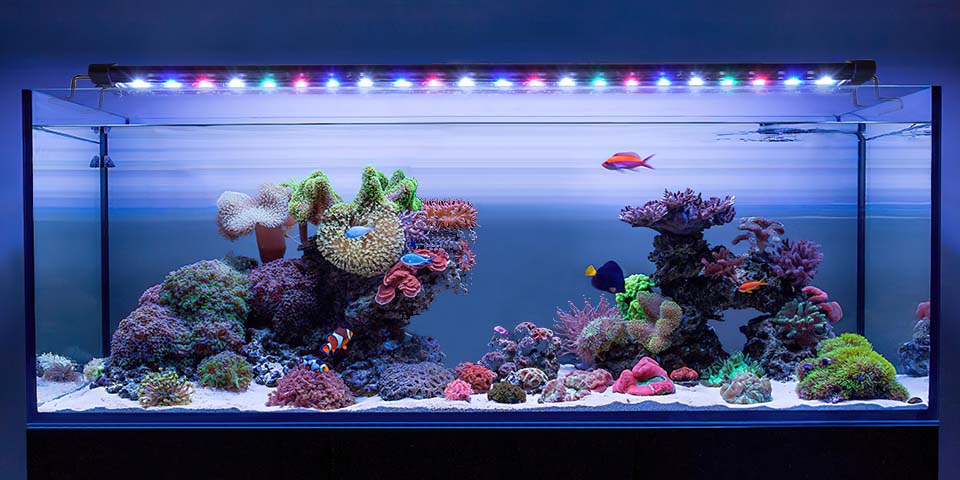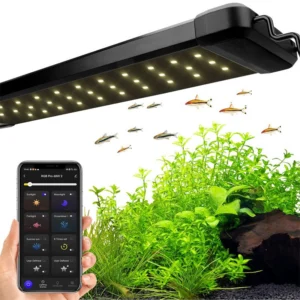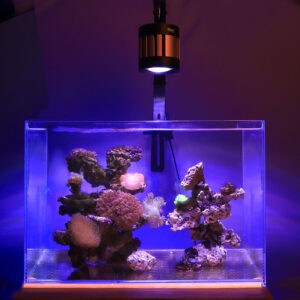When we think of coral, what do we usually think of? Is it the coral under the sea that sways freely with the current? Or are some fish moving freely in the coral bush? Perhaps, when everyone sees coral for the first time, they can’t help but marvel at its beauty. Some people may be inclined to think that coral is a beautiful plant, but in fact, coral is an image like a tree branch or brightly colored animal.
Content Table
In order to better build the underwater world and simulate the natural ecology, many fish-keeping enthusiasts have started to explore completely different paths with seawater and freshwater.
Most of the new fish keepers will build a freshwater aquarium at home, mostly with water plants and rocks as scenery materials, showing more of a landscape and forest scenery, just like Chinese ink painting, ethereal, elegant, and relaxing. When it comes to the advanced stage of the aquarium, aquarists may want to try building a saltwater aquarium.
However, it is worth noting that saltwater aquariums are mostly made of live corals, anemones, tube worms, and other scenery materials, showing a colorful underwater coral reef landscape, which is very different from the underwater scenery formed by freshwater aquariums, a completely new and fun and dynamic new world.
But with the process of building a reef tank, the question also comes up, some fish keepers may be concerned about the lights, and you may ask: Could I run my reef tank lighting too long? Or What is the best lighting for a reef tank?
If you are able to read this far, congratulations, it will solve some of your questions about the reef tank lighting situation.

What kind of light setting for coral to develop and bloom?
A reef aquarium requires an appropriate amount of light for the corals to develop and bloom. But a tank with a single light source will not do. The correct spectrum and light intensity are important for the proper growth of corals. While terrestrial plants prefer a green-blue spectrum, corals prefer a yellow-orange-red spectrum. While the depth of the water limits the intensity of the blue-green spectrum, it still makes sense to provide a full range of red, orange, and yellow light.
There are two types of lighting: standard and high intensity. Both types of lights have different spectra and color temperatures. The standard-intensity reef aquarium uses 250 to 350 PAR lights. For optimal coral development and blooming, try to use a metal halide or LED fixture with a PIR of around 400. Both of these lighting systems have an external controller and control the light settings easily.
White light contains yellow and green components. Humans evolved to see green, so they naturally tend to use yellow and green lights to grow. While many reef aquarium owners use a traditional white/blue 50/50 light balance, newer LED lights are much brighter and can shock corals and stunt their growth. Using the right light for a coral aquarium is crucial to its healthy growth.

What kind of light is needed to reach the reef ecosystem balance
One of the most important things to remember is that lighting affects the ecosystem in several ways, including the survival of algae and their appearance. Red algae, for example, have little to no green chlorophyll and are unable to thrive without the correct amount of light. This is because the red pigments in the alga, which are called phycobilins, overpower the green chlorophyll. These are the main contributors to their red appearance.
The middle of the lighting spectrum is best for many popular aquarium corals, including Physogyra, Porites, and Acropora. This range is also suitable for larger polyp-stony corals and mushroom anemones, which require less light. The intensity of light depends on latitude and season but is especially important for reef-building corals.
Plants thrive in environments with low light, which is why red and blue light are beneficial for the ecosystem. They both use different wavelengths of light to grow. While red and blue are the most common wavelengths in the sun, they are not the same. For example, blue light penetrates the deepest part of the sea, which is approximately 3300 feet deep. Despite this fact, blue and red light are complementary in nature and can boost the productivity of the entire reef ecosystem.

What is the best lighting for a reef?
LED lights are popular among hobbyists because of their low power consumption and high lumen output. They are a great choice for an aquarium because they don’t transmit heat into the water and generate heat upward, which can shorten their lifespan. However, LEDs can also be hazardous to corals because they can cause damage to the sensitive tissues of reef fish. This is why supplemental lighting is important.
LED lights are the most popular choice among aquarists. Their minimal heat production makes them the perfect choice for a reef tank. Strip LED lights are especially useful for coral development. They produce light of around 8000k which is just right for plants and other organisms. Some are even waterproof, which is helpful if the lights get accidentally submerged in the aquarium. Aside from reducing heat, LEDs also increase coral growth.
Depending on the coral species, reef tanks require 9 to 12 hours of lighting per day. The exact amount depends on the type of corals you are keeping, so a higher PAR coral will need less or more lighting time. In addition, you can customize your light schedule by using a controller. A high-quality LED light for reefs should be bright enough to make your marine animals happy.

Do corals need light at night?
Reef aquariums require a minimum of 12 hours of darkness every night. This allows corals to breathe and expel carbon dioxide. The light also stimulates algae, which creates too much sugar and oxygen. This results in coral shock and a reduced color spectrum. For these reasons, a complete dark period is necessary for coral health. A photoperiod of 16 hours is required for a healthy reef aquarium.
Corals can grow very fast under modest lighting, which can be as low as four hours a day. It is recommended that you use blue lights during the dusk or dawn hours. You can then switch to the original schedule after a month. Using a dimmer is also helpful, as this lets the marine animals get used to the new schedule and the lower intensity. A gradual increase in the lighting’s frequency and intensity will work its magic.
Corals require light for growth, but there is a limit to how much light they can absorb. The length of the photoperiod is important because optimal photosynthetic activity generates residual energy that must be released. Prolonged exposure to too much light can cause long-term damage. A wrong spectrum or too high of light intensity can harm corals, so it is important to set your lighting to the correct spectrum.

How much light do soft corals need?
While a mainstream aquarium lighting fixture produces adequate PAR levels, there are many things to consider when choosing the right light for your soft corals. While a high PAR level may seem ideal, it may actually be detrimental to your corals’ growth. Specifically, a lower PAR level will have a smaller effect on your reef tank’s fish. This is because the higher the PAR value, the more stress the soft corals will face.
The key to choosing the right amount of lighting for your SPS and LPS reef tank is to match the light spectrums of different types of corals. The amount of blue light you provide depends on the type of coral you’ve chosen and where you’re placing it. Acropora, for example, needs a higher level of PAR than other varieties of soft corals. While some species can grow in a higher-level aquarium, others require a much lower level.
A typical reef tank should be at least 480 par. This is ideal for SPS corals, as they live at the top of a reef. The higher the PAR, the better. SPS corals live on sunlight and clean water, and a high-quality aquarium should be at the same level for both. However, you should be aware that there are many exceptions to the general rule of thumb for lighting corals. For the best results, you should always check the manufacturer’s recommendations.

How long can a reef tank go without light?
A lot depends on the type of aquarium you have. Some types of tanks can handle 5 to 6 days without any light, while others cannot. If your tank is completely dark, there are many things you can do to keep your fish healthy. The most common way to do this is to use a battery-powered powerhead or backup battery to keep it from dying. Also, you can turn down the lighting intensity at night. This will create a softer mood for your fish, and will also allow you to see them later in the evening.
Another option is to use a battery backup to keep your aquarium running. This will allow specific equipment to run even during a power outage. If you have Ecotech equipment, you should get a vortech backup to ensure that it continues to run for 60 hours. This backup will also help you clean your tank. You should always have a battery backup in your aquarium.
Regardless of your choice, you should buy a PAR meter and monitor the light in your aquarium daily. This will help you set the right amount of light for the reef tank. It is also a great way to tell when to increase or decrease the light. Once you have it set up, your corals will let you know. If you are unsure of the exact amount of light required, buy window screens or shade cloth for your tank to prevent any bleaching from happening.

Some tips when building a reef tank
First, consider the size of your tank. A smaller one might be okay for a beginner. However, a taller aquarium may not be suitable for a beginner. The ideal height is eighteen inches, as these can be more challenging for beginners. Make sure that the stand you use for the aquarium is sturdy enough to hold the tools you need for aquarium maintenance. When you start building your reef tank, it is best to use acrylic or glass, as the former is lighter and better insulated, but glass is also cheaper and stronger.
Another important tip when building a reef tank is to get a quality filter. Using a reverse osmosis system will give you the best quality water for your tank. It is recommended that you use dechlorinated water to build the tank. Salt is made by mixing clean water with a dechlorinator, and it is essential to follow the directions on the label to make sure you get the right amount of salt. The goal salinity level is 1.025 for a reef.
Choosing a substrate for your tank is a crucial step. It should be high in calcium and naturally come from the ocean. It should also be relatively clean and free of contaminants. The higher the TDS, the cleaner and clearer the water will be. You can choose between hang-on and sump versions, and you should research their features carefully before making your purchase. After deciding on the size and type of your aquarium, you should choose the kind of lighting system.



Leave a comment